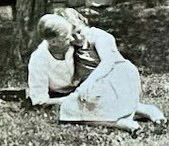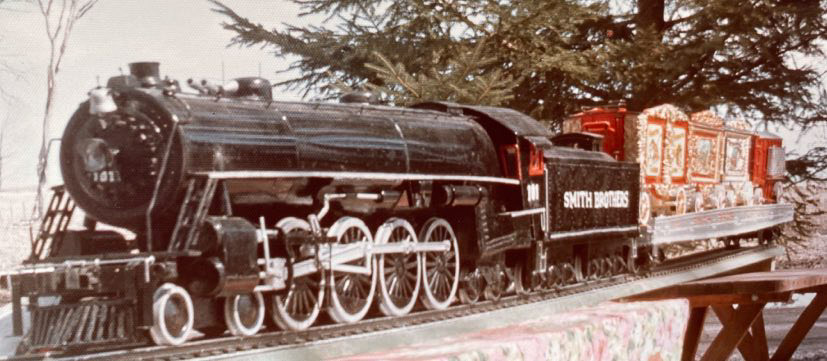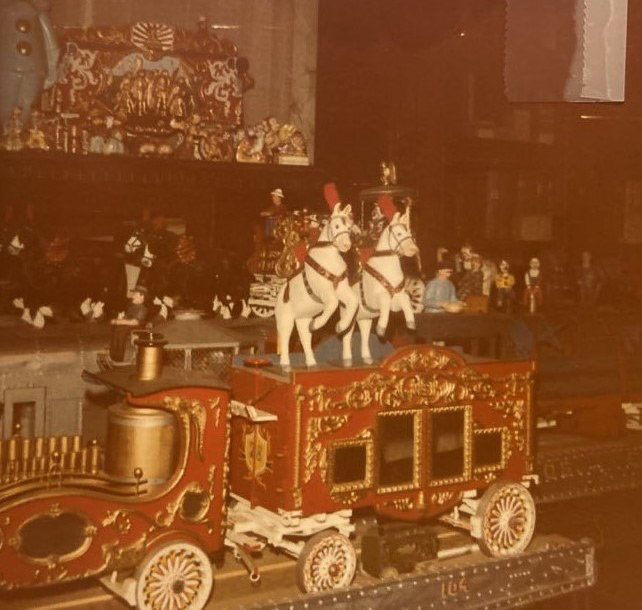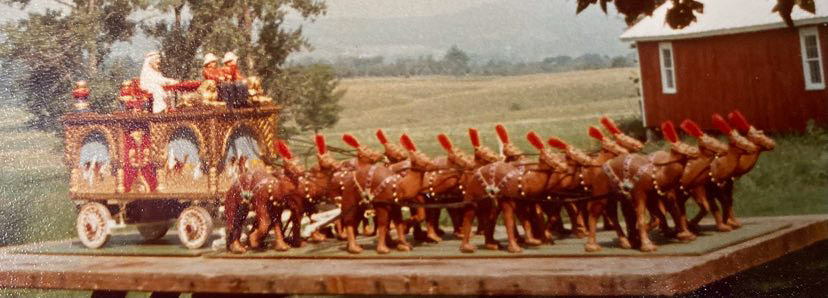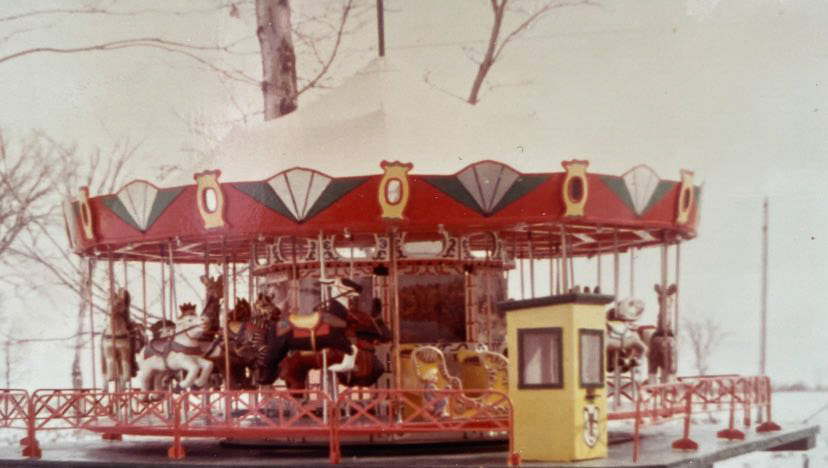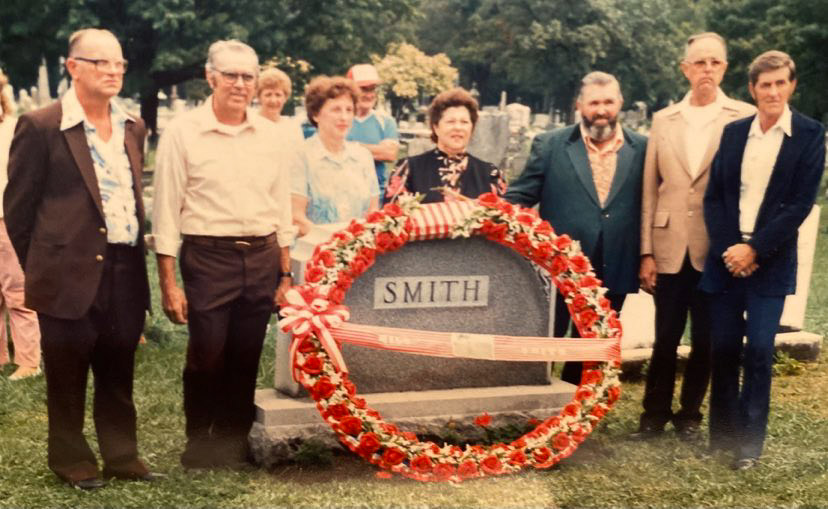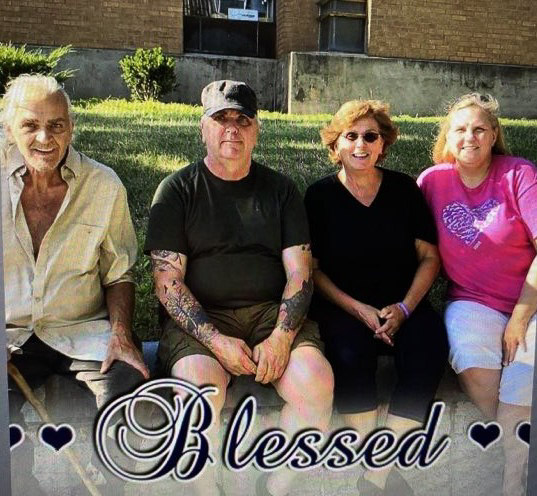AN ELEPHANT NAMED BIMBO AND A FUNERAL by Darlene Smith
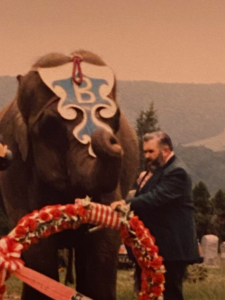
Bobby Gibbs directing Bimbo to lay the wreath at Milo’s gravesite at Oak Hill Cemetery in Herkimer, NY
Most people usually don’t have an elephant attend a family member’s funeral, but then most other families didn’t have a grandfather who loved the circus the way Milo Smith did.
COME ONE, COME ALL!
LADIES AND GENTLEMEN OF ALL AGES!
STEP RIGHT UP! EXPECT THE EXTRAORDINARY
IN THE LIFE STORY OF MILO SMITH!
Milo’s grandson, Michael I. Smith, a longtime resident of Little Falls, spent many hours of his childhood on his grandfather’s farm, the Smith Brothers Farm. Michael, having had a close bond with his grandfather, would like to share what his grandfather’s life entailed, so please make yourself comfortable and follow along as the story unfolds. We shall soon be getting to the part about an elephant named Bimbo attending a funeral, as the life story of Milo begins here…
LOVE FOR A CIRCUS
Milo, a descendant of the German Palatine Johan Jurg “Yury” Schmidt, grew up on the family farm on Smith Road, a dead-end road off Shells Bush Road in Herkimer, New York. The Smith Brothers Farm had been enjoyed as part of the Smith family’s heritage by eleven generations, beginning in 1768.
On the 7th of September in 1781, the Revolutionary War Battle of West Canada Creek took place on this very same piece of property, in the area behind the now-existing dairy barn. The land at that time was in the possession of Yury’s son, Marten. Lt. Solomon Woodworth, and twenty-one men of a contingent from Fort Dayton, lost their lives within mere minutes of each other during an ambush by the Loyalists, with the first volley killing Woodworth. On the following day, a mass burial took place on the property, where twenty-two Patriot soldiers had given their lives for America’s independence. Milo had never allowed anyone on the property to excavate, or to search for historic artifacts.
On the 6th of September in 1928, at the age of twenty-six, Milo married Mabel Gertrude Hull. Throughout their marriage, which was shortened by the death of Mabel in 1940, they welcomed six children. Michael’s father, John, was five years of age when he lost his mother. Milo went on to raise the children by himself, aided by the help of his two daughters, Beverly and Norma.
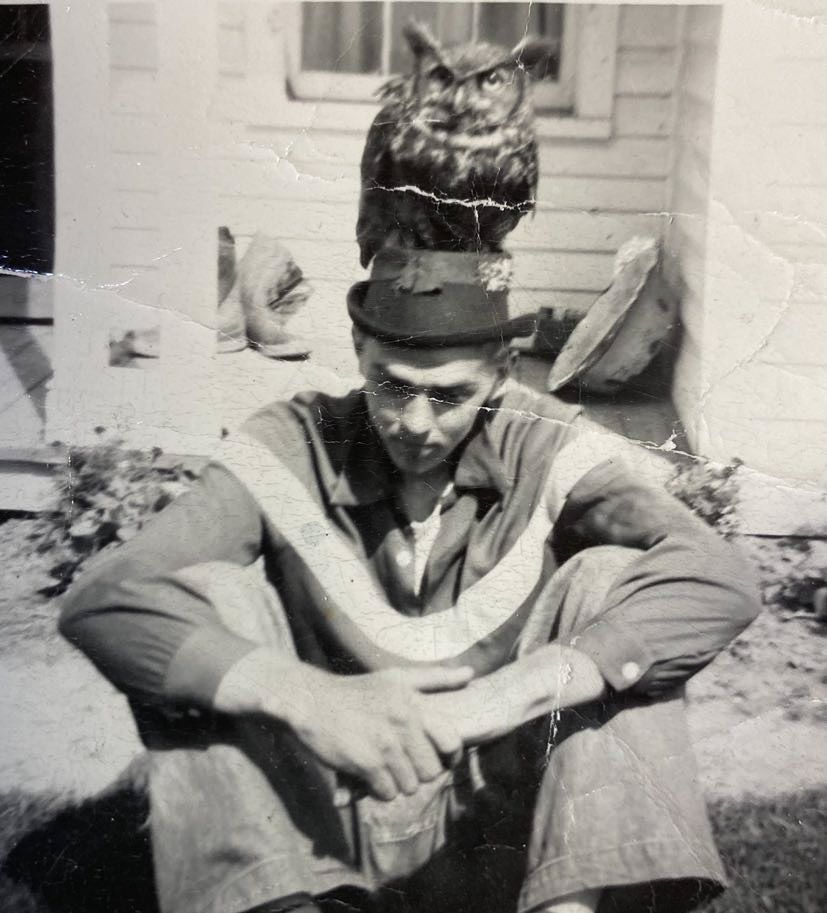
Milo’s son, John Smith, father of Michael, Jack Smith, Kathaleen Smith Ervin, and Michele Smith Mlinar | with a trained owl on his head at the Smith Brothers Farm
After the passing of Mabel, Milo took up the craft of whittling, in between caring for his young children and working on his two-hundred-and-sixty-six-acre dairy farm. Milo had taught himself how to whittle at the age of fourteen, which was something he hadn’t engaged in since his teenage years.
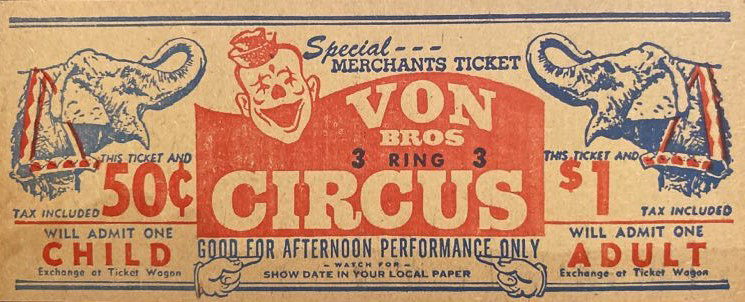
A ticket for an afternoon performance of the Von Bros Circus
Over the years, Milo and his children attended many circuses within the area, with “Circus Day” being anticipated by the family as much as any major holiday. Milo befriended numerous circus performers through the years while forming a close friendship with Bobby and Rosa Gibbs, whom he had met in 1964, at the Shrine Circus in Utica, New York. Bobby was the owner of the “Gibbs Elephants Act” and Rosa performed as an aerial acrobat artist, as the “Mexican Flyer,” of the Ford Brothers Circus. The Gibbs had resided in Seagoville, Texas, with their Asian circus elephants, Marie, Betty, and Judy.
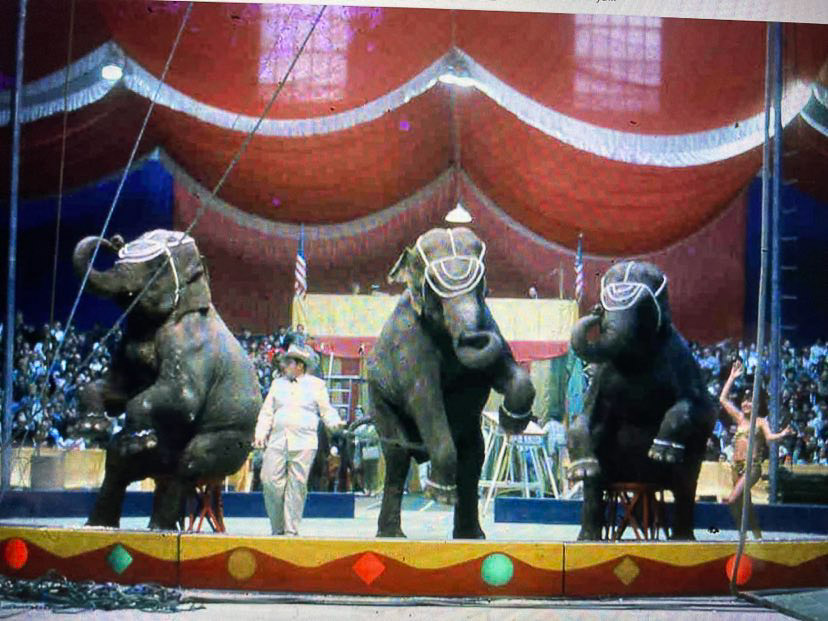
The “Gibbs Elephants Act” | Bobby & Rosa Gibbs
A great number of circus acts, including the Gibbs’, had stopped at the Smith Brothers Farm, finding a welcoming place for an extended stay as they traveled through upstate New York, which they continued to do until 2008 when the farm was sold. The homestead had been occupied by a member of the Smith (Schmidt) clan for two hundred and forty years.

Kathaleen Smith Ervin, Michael’s father – John Smith, and Michael, with the elephants, Marie, Judy, and Betsy at the Smith Brothers Farm
A BOY AND HIS SHOVEL
During circus season, Michael, starting at the age of ten, along with his siblings, Jack, Kathaleen, and Michele, were hired by their beloved grandfather to shovel elephant manure for twenty-five cents a day. When they weren’t playing with Rosa’s trapeze bars, the siblings would help with the feeding and exercising of the trained circus animals. The menagerie of circus animals included a small herd of white miniature horses, which were painted to resemble zebras for the “Dancing Zebras Act,” since zebras were difficult to train.
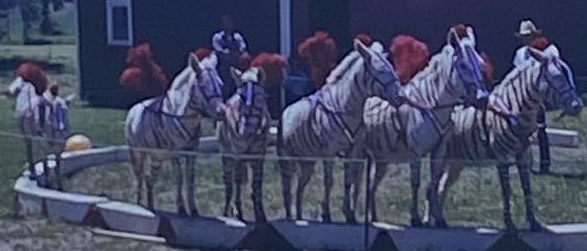
Dancing miniature horses, practicing their “Dancing Zebras Act” at the Smith Brothers Farm
REMINISCES OF VISITING CIRCUS ACTS
It wasn’t uncommon to see vehicles pass slowly by the Smith Brothers Farm when a circus act was visiting. On one such occasion, Michael and his siblings hid in the apple orchard near the farmhouse, spying on a family seated in a passing vehicle. The siblings, surrounded by the sound of their own giggles, watched the vehicle pass slowly by their hiding place. While doing so, the siblings witnessed the family’s facial expressions go from that of excitement to that of surprise, as the family caught a glimpse of the menagerie of circus animals.
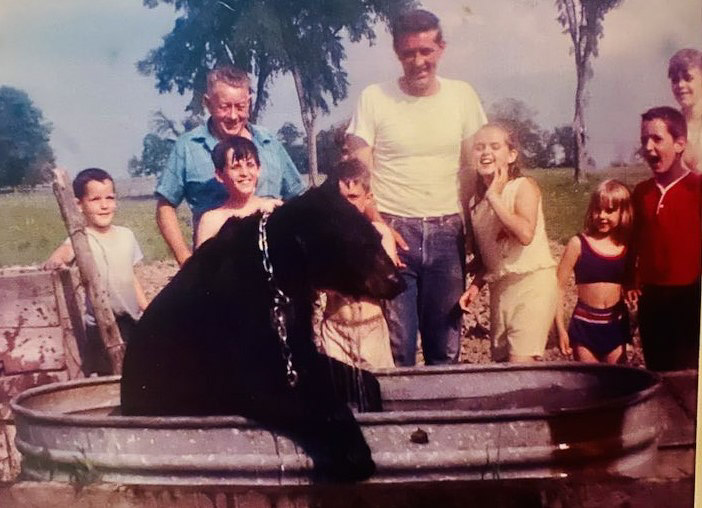
Bubbles, the little black bear, cooling off at the Smith Brothers Farm | 1st person in from the right: Jack Smith, 3rd person in from the right: Michele Smith Mlinar, and 4th person in from the right: Kathaleen Smith Ervin. The rest of the people in the photo are extended family members.
Michael and his siblings would take turns feeding Bubbles, a little black bear, a snack of honey. They would stick a wooden paint stir stick into a bucket of honey, giving the stick a twirl, before handing it to Bubbles to hold, so he could lick the honey off the stick. Bubbles took no time at all to lick the stick clean.
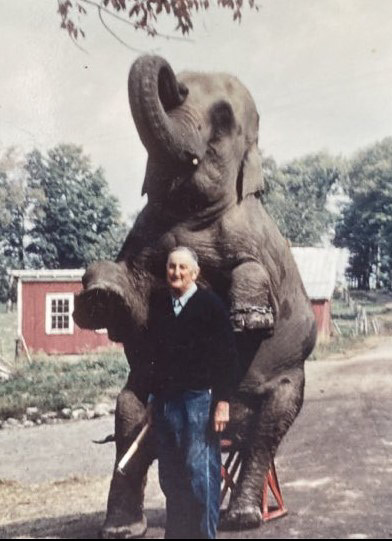
Milo, with Marie the elephant, at the Smith Brothers Farm
If you had traveled these back country roads during this time and thought that you had seen an elephant walking in the woods, chances are that you did! On another occasion, Michael and his siblings had all piled into their grandfather’s farm truck to retrieve the elephants, so they could walk them safely back to the farm. For Milo had received a phone call from an angry neighbor, Mrs. Humphrey, who lived at the end of the road. She screamed at Milo through the phone that the elephants were loose again, that they had trampled her gardens, and were drinking water out of her pool.
Michael recalls watching Bobby and Rosa Gibbs putting the elephants through their circus acts in the apple orchard, and Bobby saying, “Damnit Marie, I said trunk!” when Marie the elephant refused to give Bobby her trunk. Marie was Milo’s favorite elephant.
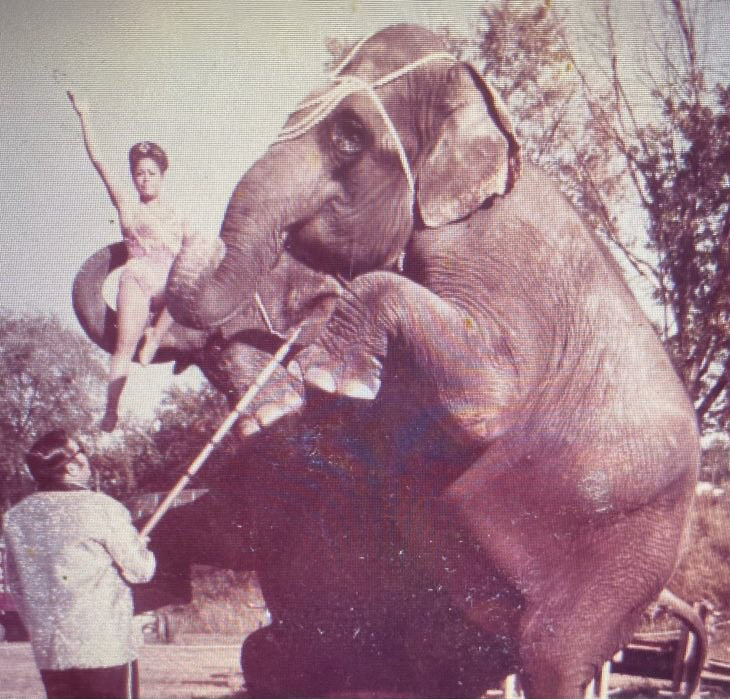
Bobby and Rosa Gibbs putting the elephants through their circus acts in the apple orchard at the Smith Brothers Farm
He also recalls an officer of the Herkimer Police Department returning a visiting circus performer to the farm, along with a black panther, because they were causing a disturbance in a local bar.
During one of Bobby and Rosa’s extended visits, Michael and his family attended a family dinner at the farm. Marlene, Michael’s mother, being the fantastic cook that she was, greeted the Gibbs with a specially made coconut cream pie, just as she had always done in the past when the Gibbs visited the farm. Marlene also brought cabbage salad for the occasion, which had been Milo’s favorite dish. After eating their meal, all the children, being Milo’s great-grandchildren, began to play a game of tag on the front lawn, since they had their fill earlier in the day of feeding the elephants and petting and cooing over the menagerie of circus animals. The rest of the family had gathered nearby on the driveway, alongside the caged tigers, to watch over the children as they played. The noise stemming from the children must have upset one of the caged tigers, for it let out a loud, snarly growl as it sprayed an adult cousin of Michael’s. At first, she shook her head in disbelief. She then began to laugh as she proceeded to walk up the driveway to the farmhouse, without having a dry spot upon her, for she had received a thorough soaking.
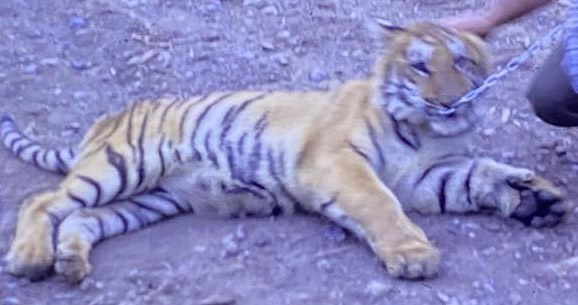
A trained tiger being exercised at the Smith Brothers Farm.
A circus act that had once visited the farm had a knife thrower amongst the circus troupe. During the visit, the knife thrower had coaxed Michael’s Aunt Dolores into volunteering to be his assistant, so he could rehearse his circus act. During the rehearsal act, the knife thrower swiftly flung knives at her, one after the other, perfectly forming Dolores’s profile. The knife thrower gave a jaw-dropping performance.
Marlene would drive Michael and his siblings over to the farm in the afternoons, so they could attend to their farm chores. Milo would often leave leftover breakfast meat, such as bacon or sausages, on a plate at the kitchen table, with the meat being left out for hours. Michael tried to be the first one into the kitchen, so he could grab a couple of pieces of the meat and run out the back door before Marlene could catch him, for she feared that the meat had spoiled. Michael is known within the family as “Iron Mike,” for his ability to digest anything.
MILO’S ASPIRATIONS

Milo’s first carved folk-art Golden Age circus wagon, the “Two Hemispheres” on display at the Museum of the American Circus in Sarasota, Florida
Finding evenings hard to bear without his Mabel, after tucking his children into bed, Milo would spend the time listening to circus music. He would sit in his dimly lit living room, which contained only one lamp with a sixty-watt light bulb, with his woodworking tools laid out before him. Amongst the scattering of wood chips that littered the living room, Milo honed his craft to become an exceptional woodcarver of miniature folk-art circus models.
In an interview that was printed in the Herkimer Evening Telegram newspaper, on the 7th of April in 1951, Milo stated his aspirations to be, “live long enough to carve a complete menagerie, with the tents, lights, and all that goes with it. The circus isn’t really a circus without tents. But that is a lifetime project.” Milo had just completed his sixth circus wagon at this time, a two-section caged wagon for animals, which was electrified with miniature lights and contained movable cage doors, so the animals could be removed. Charles Louckler, a sign painter from Auburn, NY, painted animal murals on the exterior panels of this miniature folk-art circus wagon.
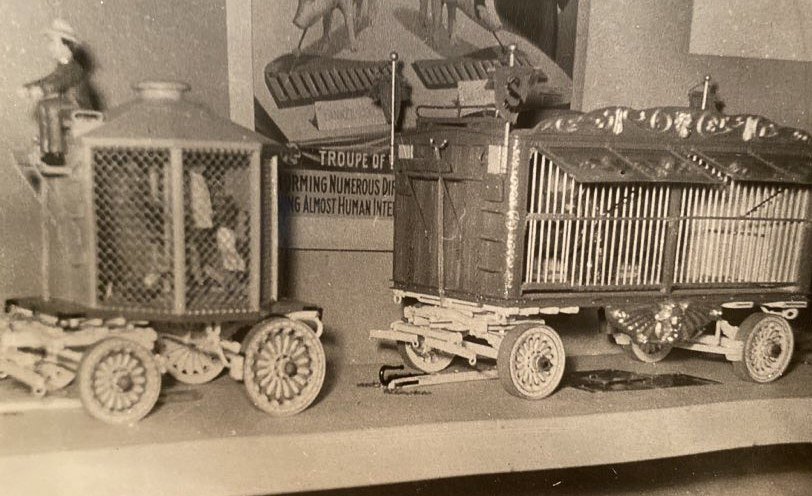
Golden Age animal circus wagons
The newspaper article also disclosed that around 1950, the first miniature folk-art Golden Age circus wagon carved by Milo, “the Two Hemispheres,” was sent to the “Museum of the American Circus” in Sarasota, Florida. The museum is now part of the present-day “Ca’d’Zan, The Ringling,” a Mediterranean Revival-style estate. The estate was built for the now-deceased John Ringling, one of the five Ringling brothers of the Ringling Brothers Circus fame. The Ca’d’Zan was designed in 1924, by the late Little Falls native, Dwight James Baum. Another circus wagon was sent to an office in Hollywood, belonging to a circus magnate of the “Greatest Show on Earth” film. The film set for the movie was the actual 1951 Ringling Bros. and Barnum & Bailey Circus and their circus troupe.
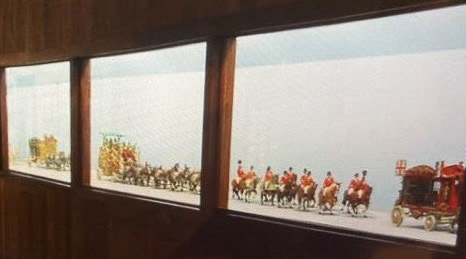
The “Circus Parade” on display, within the Circus Building at the Shelburne Museum, in Shelburne, Vermont
A CIRCUS BUILDING | THE SHELBURNE MUSEUM
In 1957, Milo, along with Charles Louckler, and two other talented woodcarvers, worked with Roy Arnold of Vermont, a world-renowned carver of miniature folk-art circus models, to complete Arnold’s “Circus Parade.” Milo carved figurines, animals, and circus wagons out of ponderosa pine for the parade, which the spectacular parade included over four thousand hand-carved pieces. The miniature folk-art circus parade of Golden Age circus wagons spans a length of five hundred feet along the exterior walls of the circus exhibit building at the Shelburne Museum, in Shelburne, Vermont. The museum’s horseshoe-shaped Circus Building was built in 1965, specifically to house the Circus Parade collection.
Milo’s miniature folk-art circus models also include two, Sig Sautelle Circus canal packet boats, which are carved replicas of the circus packet boats of the traveling Sig Sautelle Circus. The folk-art packet boats are six feet long and are named after Sautelle’s boats, “the Belle” and “the Kitty.” The Belle carried the circus troupe, and the Kitty carried the circus wagons, which contained the menagerie of circus animals. The circus wagons were built with short, spoked wheels allowing the height of the wagons to be lowered to pass under canal bridges. The Kitty also carried the cookhouse and the equipment for the circus.
The Sig Sautelle’s Golden Age circus had been based in Syracuse, New York, and had traveled up and down the three hundred and sixty-three miles of the Erie Canal on the Belle and the Kitty. The Sig Sautelle Circus traveled by packet boat from 1882 through 1889. During the winter months when the canal was frozen, Sautelle would turn the Belle into a saloon, where he conducted dog circus acts for the entertainment of his patrons. In 1890, the circus then traveled from city to city by rail until 1904 when it was purchased by James McCaddon of the Barnum and Bailey Circus. Milo’s miniature canal packet boats are on display in the Circus Building, at the Shelburne Museum.
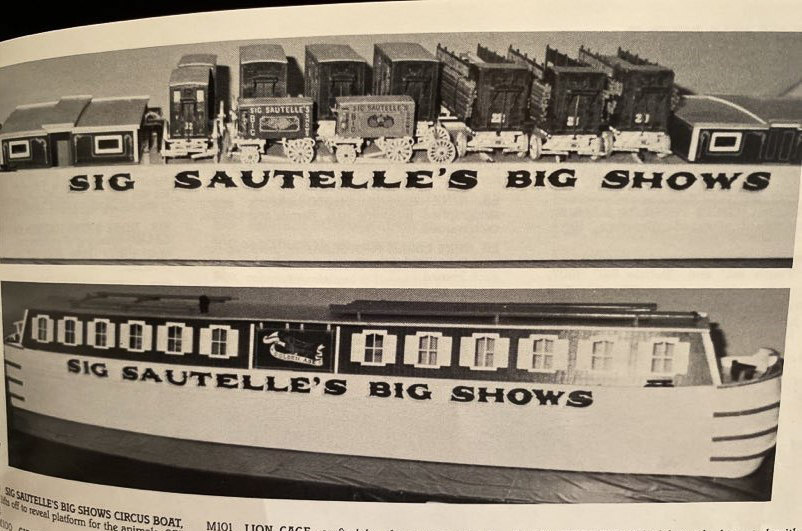
The Kitty -notice the circus wagons on board that carried the menagerie of circus animals & the Belle, replicas of Sig Sautelle packet boats, that were each listed to sell for between $1,500. – 2,000. in the 1986 Guernsey’s Auction House Catalog
THE SIG SAUTELLE CIRCUS AT LITTLE FALLS
The traveling Sig Sautelle Circus stopped at Little Falls, in September of 1898. On the morning of the 25th, the circus troupe pitched their big top in a circus lot at the top of Church Street. A grand circus street parade was held at noon that day, with throngs of people crowding the city streets. The Sig Sautelle Circus, being a one-ring circus, held two performances on the 26th, with one held in the afternoon and one held in the evening, with an admission price of twenty-five cents. Sautelle conducted his show in the massive ring where some of the most daring circus acts ever were performed, with such a sight to behold, the circus troupe thrilled the audience. At the close of the show, the audience gave Sautelle a standing ovation.
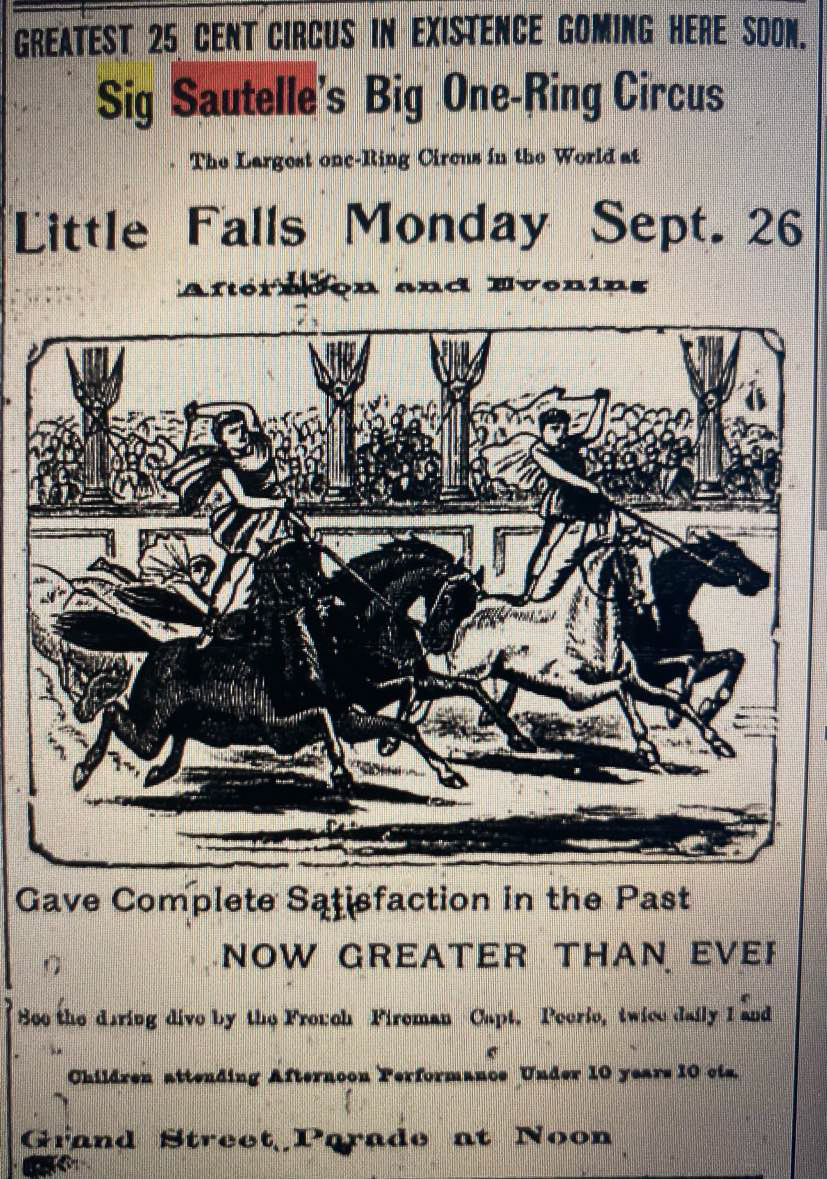
The traveling SIG SAUTELLE CIRCUS poster ad, which was advertised in the Little Falls Journal and Courier Newspaper on the 14th of September in 1898
LAURA BELL
On the 5th of October in 1966, at the age of sixty-four, Milo married his companion, Laura Bell Helmer Osborne, a former Herkimer elementary school teacher, with her being at the age of seventy-five. At the end of the day, they would retire to their respective homes, with her at the old Osborne homestead at the base of Osborne Hill Road, Herkimer, New York. Milo would joke that he and his wife had twin beds five miles apart, with Laura Bell passing away on the 30th of October in 1979.
SMITH BROTHERS CIRCUS
For forty years, Milo carved numerous miniature folk-art circus models, as he created the “Smith Brothers Circus.” The circus is named after his four sons, Wilfred, Adelbert, John, and Ronald, who was known for his country music fame. The Smith Brothers Circus was carved as a model of a traveling circus that traveled by train, in a miniature configuration. The circus train featured accurate reproductions of circus wagons used by Golden Age circuses. Golden Age circuses were one of the first popular forms of family entertainment in America, spanning from the 1870s through the 1930s. In 1919, when the circuses of the Golden Age were at their peak, the Ringling Brothers Circus and the Barnum & Bailey Circus merged to form the Ringling Bros. and Barnum & Bailey Circus. The newly formed circus became known as the “Greatest Show on Earth.” Milo carved his folk-art Golden Age circus wagons in miniature scales of one inch to one foot, from photos, memories, circus posters, and brochures that he had collected from the circuses that he had attended during his youth.
The Smith Brothers Circus train was eighty-seven feet in length and was set upon a connecting track. The miniature folk-art Golden Age circus train was conducted by a custom-made, black metal locomotive. Each of the forty circus wagons of the train transported a section of the circus. When the circus wagons were emptied of their cargo, a miniature folk-art Golden Age circus could be assembled, forming the Smith Brothers Circus. The circus wagons were painted in vivid colors, with elaborately detailed, hand-painted side panels that were edged in gold, with one being painted with the portraits of Milo’s four sons. Milo’s grandson Jack, a son of John’s, being a woodworker who creates twig furniture, contributed his artistic abilities in his youth by painting a few of the circus wagons alongside his grandfather.
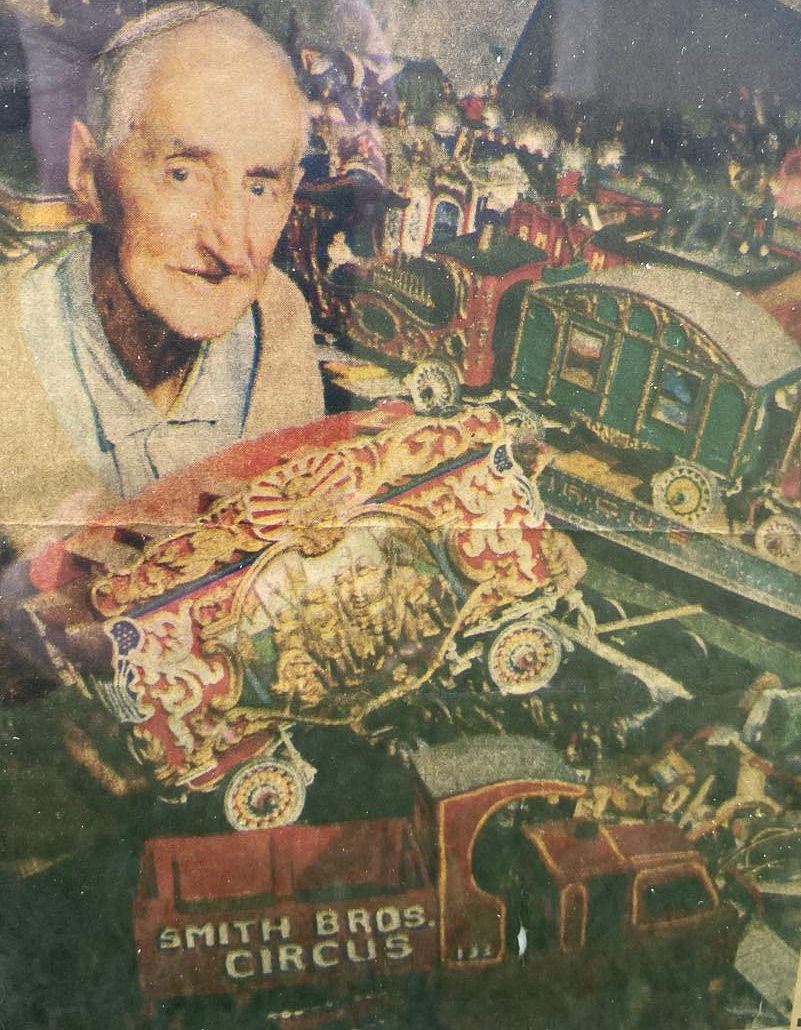
1980 Milo sitting in his living room amongst his 40 carved Golden Age circus wagons of the Smith Brothers Circus – Milo is holding the “Pawnee Bill” wagon, one of his favorite wagons
Milo carved a “Big Top” as part of the Smith Brothers Circus that contained rows of bleachers under the grand circus tent, which were filled with carved figurines, depicting people as an awaiting audience in gleeful anticipation. Each figurine was carved to resemble a past circus performer that he had admired or had personally known. He carved numerous circus acts, such as dancing horses and clown acts, including the Ringling Brothers and Barnum and Bailey’s hobo clowns, Emmet Kelly and Lou Jacobs. Milo’s carvings included Jacobs’s motorized car, bathtub, and baby carriage. He also carved a fully operational carousel, which had three rows of animals, which lit up with miniature lights, as each animal moved up and down, as the carousel rotated to music.
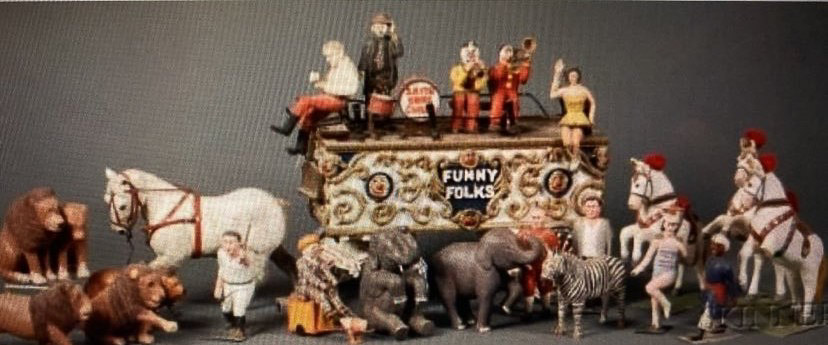
Carved figurines of the folk-art circus acts that were carved by Milo, also included is the “Funny Folk’s” circus act wagon
Most of these miniature folk-art circus models were sold at auction at Guernsey’s of New York City on November 1st and 2nd in 1986. Their catalog listed eighty-four miniature folk-art Golden Age circus models carved by Milo, with prices ranging from $200 to $7,000. The circus models are now in the private collection of a circus memorabilia collector in Goshen, New York. The carousel is in a private circus collection in California.
Milo’s work is known globally in the circus world of hand-carved folk-art miniatures. He was a past director for the Circus Model Builders Association and a past member of the Circus Fans Association of America, the National Woodcarvers Association, and the Circus Historical Society.
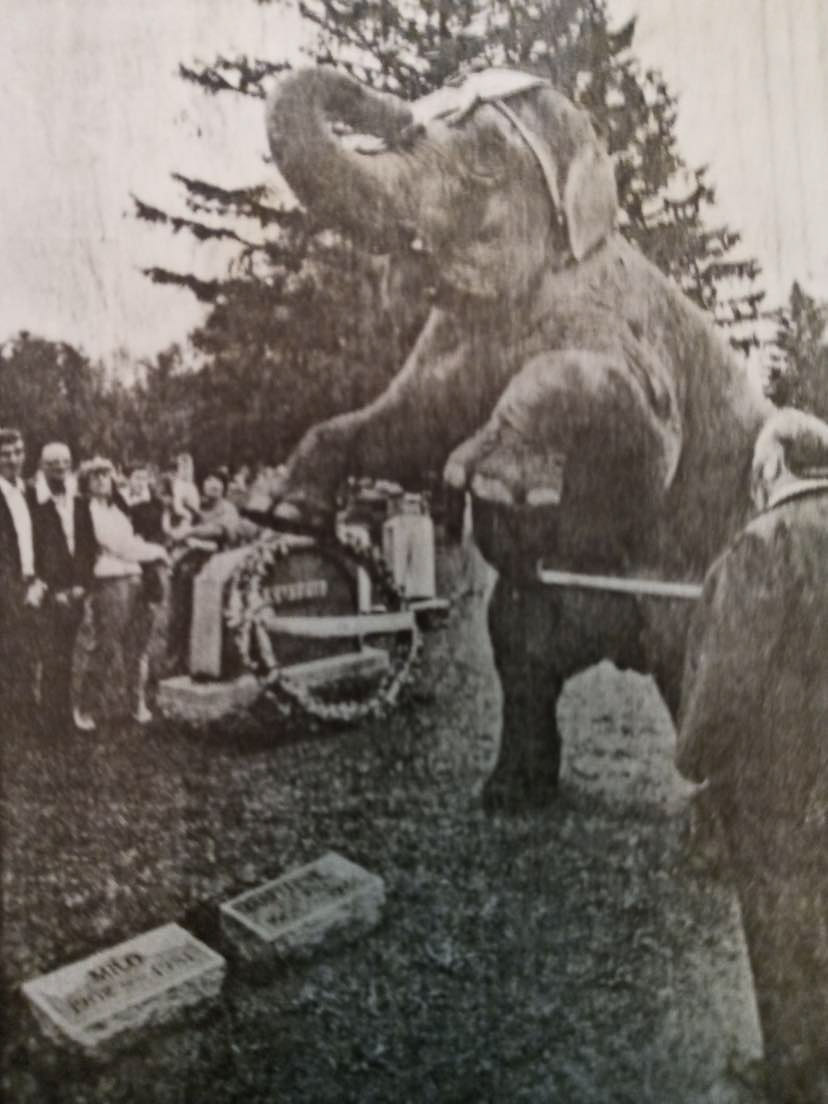
Newsprint of Bimbo performing circus tricks after he had laid the wreath at Milo’s grave at Oak Hill Cemetery, Herkimer, NY
A LONE REQUEST FULFILLED
Milo made a lone request to the Gibbs, who received free room and board for their family and circus menagerie, spanning over forty years at the Smith Brothers Farm. His request was to have an elephant lay a wreath at his grave upon his death, so his love for the circus wouldn’t be forgotten. Milo sadly passed away at the age of seventy-nine. The Gibbs brought “Bimbo,” a four-ton Asian elephant of the Ford Brothers circus to Milo’s graveside service, which was held at Oak Hill Cemetery in Herkimer, New York, on the 6th of September in 1985. After giving an outstanding performance of circus tricks, Bimbo laid a wreath of red flowers alongside Milo’s headstone, with Bobby and Rosa Gibbs honoring Milo’s request, being the “Greatest Show at a Funeral.”
Written by Darlene Smith as a gift to her husband, Michael I. Smith, who is also a son of John’s, being a talented woodworker himself, who just recently built the Take a Book – Leave a Book “Little Green Library,” that bears the resemblance of a bookery of yesteryear and sits on the stone veranda at the Little Falls Historical Society Old Bank Building Museum.
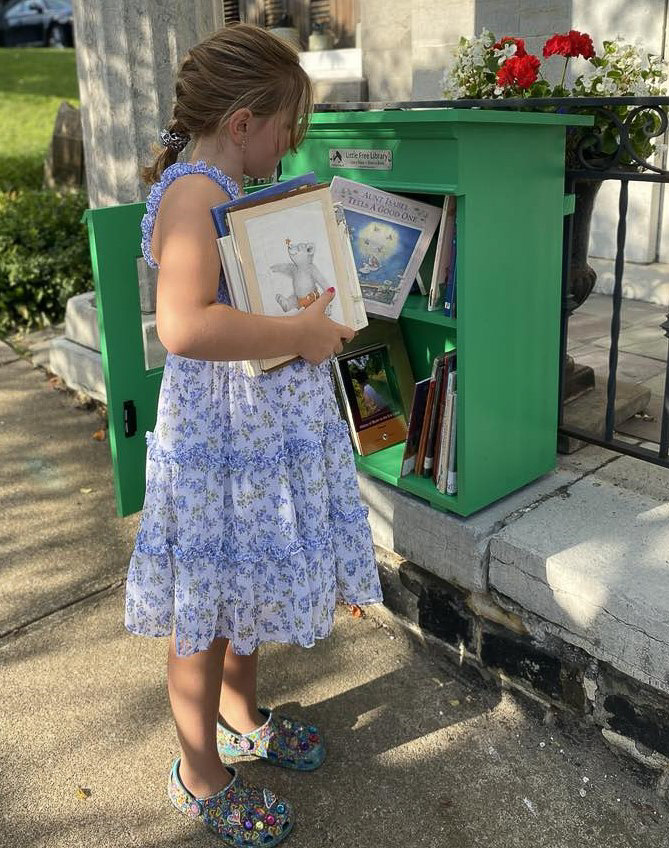
The Little Falls Historical Society’s Take a Book – Leave a Book “Little Green Library” being filled with books by Michael’s granddaughter, Eleanor
Michael I. and Darlene Smith are both members of the Little Falls Historical Society.


